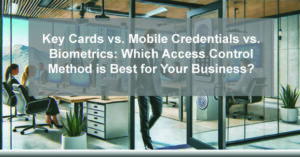
Key Cards vs. Mobile Credentials vs. Biometrics: Which Access Control Method is Best for Your Business?
Security is a top priority for businesses of all sizes, and choosing the right access control system is crucial for protecting employees, assets, and sensitive data. But with multiple options available—key cards, mobile credentials, and biometric access control—how do you decide which one is best for your business?
What Is Access Control and Why Does It Matter?
Access control systems regulate who can enter a building or specific areas within a facility. These systems replace traditional keys with electronic credentials, providing better security, flexibility, and tracking.
- ✅ Prevent unauthorized entry
- ✅ Reduce security risks like lost or stolen keys
- ✅ Monitor and log entry activity
- ✅ Enhance convenience for employees and visitors
Key Cards: The Traditional Yet Reliable Option
How Key Card Access Works
Key cards are RFID or NFC-enabled devices used to tap or swipe for access. They’re typically assigned to specific employees and programmed with permissions for certain times or areas.
Pros of Key Cards
- ✅ Familiar and easy to use
- ✅ Inexpensive to issue
- ✅ Easy to deactivate and replace
Cons of Key Cards
- ❌ Can be lost or stolen
- ❌ Risk of cloning
- ❌ Require physical management and tracking
Best for: Budget-conscious businesses with moderate security needs and a high employee turnover rate.
Mobile Credentials: The Modern, Contactless Solution
How Mobile Access Control Works
Mobile access uses smartphones and apps as digital credentials. Entry is granted through Bluetooth, NFC, or QR-code scanning, depending on system configuration.
Pros of Mobile Credentials
- ✅ No need for physical cards
- ✅ Contactless entry
- ✅ Real-time access management via cloud
- ✅ More secure than plastic cards
Cons of Mobile Credentials
- ❌ Requires employees to carry smartphones
- ❌ May face compatibility/setup challenges
- ❌ Possible employee privacy pushback
Best for: Tech-forward offices aiming to simplify credential management and reduce physical hardware.
Biometric Access Control: The Most Secure and High-Tech Option
How Biometric Access Works
Biometric systems rely on fingerprints, facial recognition, or iris scans to grant access. Data is stored securely and matched during each access attempt.
Pros of Biometrics
- ✅ Impossible to lose or duplicate
- ✅ No cards or phones required
- ✅ Fast and convenient for users
Cons of Biometrics
- ❌ Higher upfront investment
- ❌ Privacy concerns
- ❌ May be less effective in harsh or dirty environments
Best for: Data-sensitive businesses, government facilities, and those seeking top-tier security with minimal friction.
Comparison Table: Which One Is Right for You?
| Feature | Key Cards | Mobile Credentials | Biometrics |
|---|---|---|---|
| Security Level | Moderate | High | Very High |
| Convenience | Moderate | High | High |
| Risk of Loss | High | Low | None |
| Cost | Low | Moderate | High |
Final Thoughts: What’s Right for You?
There’s no one-size-fits-all. You may even benefit from a hybrid approach—combining key cards for general access and biometrics for high-security zones.
📞 Want expert guidance? ABT is Colorado’s trusted provider of access control systems. We’ll help you design, deploy, and support a solution that fits your space, budget, and future growth.
